| Metlink | |
|---|---|
 | |
   From top left to bottom right: Matangi train at Paekākāriki station, Metlink bus on Lambton Quay, and the Wellington Cable Car From top left to bottom right: Matangi train at Paekākāriki station, Metlink bus on Lambton Quay, and the Wellington Cable Car | |
| Overview | |
| Locale | Greater Wellington |
| Transit type | Suburban rail, bus, funicular, ferry |
| Annual ridership | 37.6 million (2023/24) |
| Website | metlink.org.nz |
| Operation | |
| Operator(s) | Tranzurban, Uzabus, NZ Bus, Mana Coach Services, Transdev Wellington, Wellington Cable Car Ltd, East by West Ferries |
Public transport in the Wellington Region, branded under the name Metlink, is the public transport system serving Wellington and its surrounding region. It is the most used public transport system in New Zealand per capita, and consists of electric and diesel buses, suburban trains, ferries and a funicular (the Wellington Cable Car). It also included trams until 1964, and trolleybuses until 2017.
Buses and ferries are privately owned, with the infrastructure owned by public bodies, and public transport is often subsidised. The Greater Wellington Regional Council is responsible for planning and subsidising public transport, and pays around NZ$30 million for bus and train services each year. The system covers Wellington City, Lower Hutt, Upper Hutt, Porirua, the Kāpiti Coast and the Wairarapa.
System
Extent
The Regional Council's Regional Public Transport Plan notes that Wellington had in 2019:
- a rail network with around 83 multi-units and 24 carriages, which serve 48 stations.
- a bus network with 457 buses serving 3,179 stops on around 232 routes.
- two harbour ferries.
- a five-station funicular, the Cable Car.
GIS information indicates that 77% of the region's population lives within 800 metres of public transport stop with a 30-minute frequency or better.
Wellington's hilly terrain has a considerable effect on public transport. Some planners consider Wellington to be a "good" city for public transport management, as the topography concentrates settlement in valleys or along coastlines, providing clear, dense "corridors" for transport routes. At the same time, however, the hilly terrain proved a hindrance for the construction of rail and tram lines, and buses sometimes have difficulty on narrow and winding streets.
Usage
According to Metlink, over 40 million passenger trips were made by public transport in Wellington in 2018/2019, and this number has been growing in recent years. The Wellington region has the highest per capita use of public transport in New Zealand, with 72.65 trips per capita in the year ending September 2019.
Of the approximately 37.33 million trips, around 24.33 million are made by bus, 12.80 million by train, and 0.18 million by ferry.
| Year | Bus | Ferry | Rail | Total patronage |
|---|---|---|---|---|
| 2001/02 | 19,795,687 | 114,163 | 10,163,061 | 30,072,911 |
| 2002/03 | 20,711,898 | 117,027 | 10,010,448 | 30,839,373 |
| 2003/04 | 21,338,606 | 127,110 | 9,953,408 | 31,419,124 |
| 2004/05 | 21,902,604 | 137,844 | 10,253,811 | 32,294,259 |
| 2005/06 | 23,487,552 | 155,799 | 11,097,423 | 34,740,774 |
| 2006/07 | 22,794,990 | 156,718 | 11,175,993 | 34,127,701 |
| 2007/08 | 22,964,384 | 177,128 | 11,552,453 | 34,693,965 |
| 2008/09 | 23,381,247 | 179,981 | 11,875,820 | 35,437,048 |
| 2009/10 | 23,647,840 | 182,034 | 11,133,677 | 34,963,551 |
| 2010/11 | 24,026,904 | 176,581 | 11,202,227 | 35,405,712 |
| 2011/12 | 24,111,291 | 176,698 | 11,274,141 | 35,562,130 |
| 2012/13 | 23,607,936 | 192,549 | 11,355,403 | 35,155,888 |
| 2013/14 | 23,981,194 | 180,155 | 11,643,292 | 35,804,641 |
| 2014/15 | 24,098,765 | 179,106 | 12,128,995 | 36,406,866 |
| 2015/16 | 24,331,408 | 197,889 | 12,801,182 | 37,330,479 |
| 2016/17 | 24,437,473 | 195,751 | 13,121,525 | 37,754,749 |
| 2017/18 | 24,716,617 | 204,209 | 13,552,866 | 38,473,692 |
| 2018/19 | 24,746,993 | 202,201 | 14,323,878 | 39,273,072 |
| 2019/20 | 21,335,320 | 165,382 | 11,489,110 | 32,989,812 |
| 2020/21 | 21,670,682 | 167,648 | 11,270,837 | 33,109,167 |
| 2021/22 | 17,654,506 | 137,424 | 8,133,999 | 25,925,929 |
| 2022/23 | 22,272,833 | 194,661 | 10,711,688 | 33,179,182 |
Patronage data from the 2018/19 year is not directly comparable with previous years, particularly for bus services, due to changes in the reporting method for statistics related to the implementation of new bus contracts in the region. Details may be found in the cited spreadsheet.
COVID-19 affected statistics for all modes from late March 2020
Ticketing
Snapper cards pay for most services under Metlink, excluding Ferries; and has been used on bus services since 2009; for trains, it was first introduced on the Johnsonville Line since 2021; and on the Hutt Valley Line, Kapiti Line, Melling Branch and the Wairarapa Connection since November 2022. Tickets for single bus and train rides can still be purchased on board using cash.
Snapper cards are being replaced by the National Ticketing Solution; branded as Motu Move. This is expected to occur in 2026 for the Wellington Region.
Modes
Buses
See also: List of bus routes in the Wellington Region and Trolleybuses in Wellington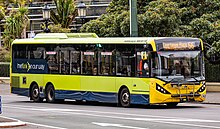
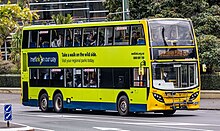
Wellington has an extensive network of bus routes. The routes are determined by the Regional Council, which regulates commercially provided services and solicits bids from private operators to run the services it is prepared to subsidise.
From July 2018, the largest operator is Tranzit Group, which provides services for most of Wellington City, the Hutt Valley, and the Wairarapa under the Tranzurban brand. In Porirua and the Kāpiti Coast most services are provided by Uzabus. Other bus providers in the region include Mana Coach Services (owner of Newlands Coach Services) which provides services in the northern suburbs and Tawa, and NZ Bus which provides services from Eastbourne and the east-west spine between Karori and Miramar. Prior to July 2018, the largest operator was NZ Bus, which provided services for most of Wellington City under the GOWellington brand and for the Hutt Valley under the Valley Flyer and Runciman Motors brands. In Porirua and the Kāpiti Coast most services were provided by Mana Coach Services.
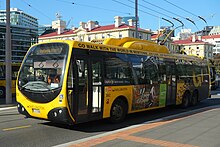
The majority of buses in the Wellington area are powered by diesel, but GOWellington also had 60 trolleybuses that it operated within Wellington city. The trolleybus network was introduced between 1949 and 1964 to replace Wellington's trams (see below) and closed down in October 2017. From July 2018, Tranzit will introduce electric buses progressively onto their routes; the Greater Wellington Regional Council has also voted to look into proposals to make both rapid transport spines, Johnsonville to Island Bay and Karori to Seatoun, fully electric by 2021 and 2023 respectively and make a core route in both the Hutt Valley and Porirua fully electric as electric buses are introduced. As of April 2024, Wellington has 103 electric buses in urban service, the second highest electric fleet in New Zealand after Auckland which has 133 electric buses. Since 2018, new diesel buses on Metlink routes are required to be at least Euro V standard.
All Metlink buses accept the contactless Snapper card. As of April 2011, Wellington buses report real time location information which is displayed on electronic signs in some Wellington bus stops and can be viewed online.
From 2019, bike racks have been fitted to most buses operated in Metlink branding.
Tawa has 5 on-demand minibuses operated by Mana for a year's trial from 16 May 2022.
Trains
Transdev Wellington operates Metlink's five-line 154-kilometre (96 mi) commuter network, which fans north out of Wellington railway station as far as Waikanae in the north and Masterton in the east. Transdev Wellington operates the service under contract to the Greater Wellington Regional Council with rolling stock (except for diesel locomotives used on the Wairarapa services) owned by the council, and rail infrastructure owned by KiwiRail. Until 2016 KiwiRail division Tranz Metro had the contract to operate Metlink's services.
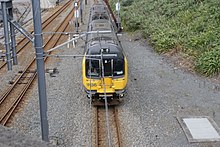
Since July 2016, Wellington's commuter rail services have been operated by Transdev Wellington. Transdev subcontracts KiwiRail to provide and operate the diesel locomotives on the Wairarapa services. In the year ending 30 June 2017, 88.3% of rail services ran on time; this figure is lower than previous years, as timeliness is now measured directly by Metlink rather than relying on self-reporting by the operator, and is measured at all key stations rather than just Wellington Station.
There are two major rail corridors in Wellington. The North Island Main Trunk (NIMT) runs along the western coastline, passing through Porirua and Paraparaumu to Waikanae on the Kāpiti Coast (known as the Kapiti Line); the Wairarapa Line runs along the edge of Wellington Harbour and then up the Hutt Valley, passing through both Lower and Upper Hutt (known as the Hutt Valley Line). Less frequent services continue through the rural Wairarapa, stopping at a number of small towns before terminating at Masterton. There are also the Johnsonville Line in the north of Wellington and the Melling Line on the western side of Lower Hutt. The Kapiti Line and Hutt Valley Line are mostly double track, except for a short stretch on the Kapiti Line between Muri and Paekākāriki (the North–South Junction) and between the Waikanae River and Waikanae station. The Johnsonville line is single track with passing loops, while the Melling lines is single track throughout.
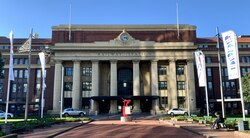
There are 49 stations in the rail network, all except Wellington railway station owned by Greater Wellington Regional Council. Wellington station is the busiest by far, with trains arriving and departing every few minutes at peak times. The next busiest stations are Porirua, Waterloo (in Lower Hutt) and Johnsonville. Most stations are served by only one line.
Most trains are the FP class Matangi electric multiple units, in sets of two to eight cars, introduced from 2011. They displaced the older DM class English Electric units, the last of which were withdrawn from service in 2012, and the EM class Ganz Mavag units, the last of which were withdrawn from service in 2016. The Wairarapa line beyond Upper Hutt is not electrified, so the Wairarapa Connection trains to Masterton are diesel-hauled with SW and SE class carriages.
There are long-distance trains to Palmerston North (the Capital Connection commuter train) and Auckland (the Northern Explorer). These are not part of the Wellington transport system.
History
Electric suburban services began in July 1938, following the opening of the Tawa flat deviation of the North Island Main Trunk (NIMT). The Johnsonville Line, the former route of the NIMT out of the capital, was the first line to be electrified. By 1940 the NIMT (the present Kapiti Line) had been electrified as far north as Paekākāriki.
The Hutt Valley Line was electrified to Taitā in 1953 to coincide with major state housing developments in the area. In 1954, the Wairarapa railway line was diverted between Petone and Haywards via Waterloo and Taitā, with the old line truncated to Melling to form the Melling Line. Electrification was extended to Upper Hutt in 1955.
Also in 1955, the 9 km Rimutaka Tunnel between Upper Hutt and Featherston opened, bypassing the laborious Rimutaka Incline and reducing the travel time from Wellington to Featherston to just over one hour, and from Wellington to Masterton to one-and-three-quarter hours. The Wairarapa Connection service started nine years later, after morning and afternoon peak services started to exceed the 176-seat capacity of the diesel railcars (twin NZR RM class) then used.
Electrification was extended to Paraparaumu in 1982, and to Waikanae in February 2011 to coincide with the arrival of the new Matangi electric multiple units. The (diesel-hauled) Capital Connection to Palmerston North also operates on this route.
In April 2023 the Wellington rail network faced weeks of delays because of 70 kph speed limits on all lines after rail evaluations by the broken track evaluation car had not been scheduled for May 2023, although the period was subsequently reduced to the week of May 1 to 5. These safety checks are due every four months. NZR has one track evaluation car; which required an annual inspection .The repairs required were restricted to turning of wheels.
Patronage
In 1983 the extension of electrification to Paraparaumu led to a rise in Wellington suburban rail passenger journeys to 13.6 million in 1983/84, higher than it had been for some years. But in the following decade there was a substantial decline, due to higher car ownership, more motorways and Government and corporate restructuring. There were only 8.5 million journeys in 1994/95 and 1995/96, though with a slow increase to in the late 1990s with high petrol prices to 10.0 million in 2000/01. This decline and with little interest by Tranz Rail (who had tried and failed to sell the Wellington operation in 2002) did not result in purchase of any new rolling stock after the Ganz-Mavag units in 1982. Most of the English Electric units were ordered in 1946 and were nearly 50 years old (although the earlier 38 & 42 units had been retired) and the 25 sets in use in 1990 had dropped to 14 in 2001. But their gradual retirement had to stop in the 1990s, and in 2004 refurbishment of 36 (later 37) cars at a cost of $5.4 million and taking from 2000 to 2008 was agreed. Some preserved sets were leased back; the Ferrymead, Phoenix and Cyclops sets.
But by 2006 the GWRC were concerned that trains were struggling to cope with increasing passenger numbers in peak hours, with an 11% increase in 2005/06 over the previous year. Toll Rail had no spare diesel locomotives with many used on increased Auckland demand for suburban commuter trains after the opening of the Britomart Centre. So the use of three EO locomotives surplus from the Otira Tunnel was agreed. They new role from 2008 to 2011 was on the Kapiti Line to Plimmerton and the Hutt Valley Line to Upper Hutt. Their slow acceleration meant that on the Hutt run stops at Pomare and Manor Park were omitted to keep to timetable. Two locos were used - 'topping and tailing' the trains. In 2011 some Melling trains were replaced by buses to release trains for the Hutt and Kapiti lines.
An average of 930,000 trips are made on Metlink trains each month. In 2013-14, Tranz Metro claimed 94.3% punctuality, being the proportion of trains arriving within five minutes of schedule (94.7% punctuality if normalised for the effects of the 2013 Seddon earthquake and 2013 Lake Grassmere earthquake).
In 2024 it was reported that the passenger numbers had collapsed since 2020, with an increase in working from home during and since the Covid epidemic, particularly on Mondays and Fridays.
Services
| Metlink network | ||||||||||||||||||||||||||||||||||||||||||||||||||||||||||||||||||||||||||||||||||||||||||||||||||||||||||||||||||||||||||||||||||||||||||||||||||||||||||||||||||||||||||||||||||||||||||||||||||||||||||||||||||||||||||||||||||||||||||||||||||||||||||||||||||||||||||||||||||||||||||||||||||||||||||||||||||||||||||||||||||||||||||||||||||||||||||||||||||||||||||||||||||||||||||||||||||||||||
|---|---|---|---|---|---|---|---|---|---|---|---|---|---|---|---|---|---|---|---|---|---|---|---|---|---|---|---|---|---|---|---|---|---|---|---|---|---|---|---|---|---|---|---|---|---|---|---|---|---|---|---|---|---|---|---|---|---|---|---|---|---|---|---|---|---|---|---|---|---|---|---|---|---|---|---|---|---|---|---|---|---|---|---|---|---|---|---|---|---|---|---|---|---|---|---|---|---|---|---|---|---|---|---|---|---|---|---|---|---|---|---|---|---|---|---|---|---|---|---|---|---|---|---|---|---|---|---|---|---|---|---|---|---|---|---|---|---|---|---|---|---|---|---|---|---|---|---|---|---|---|---|---|---|---|---|---|---|---|---|---|---|---|---|---|---|---|---|---|---|---|---|---|---|---|---|---|---|---|---|---|---|---|---|---|---|---|---|---|---|---|---|---|---|---|---|---|---|---|---|---|---|---|---|---|---|---|---|---|---|---|---|---|---|---|---|---|---|---|---|---|---|---|---|---|---|---|---|---|---|---|---|---|---|---|---|---|---|---|---|---|---|---|---|---|---|---|---|---|---|---|---|---|---|---|---|---|---|---|---|---|---|---|---|---|---|---|---|---|---|---|---|---|---|---|---|---|---|---|---|---|---|---|---|---|---|---|---|---|---|---|---|---|---|---|---|---|---|---|---|---|---|---|---|---|---|---|---|---|---|---|---|---|---|---|---|---|---|---|---|---|---|---|---|---|---|---|---|---|---|---|---|---|---|---|---|---|---|---|---|---|---|---|---|---|---|---|---|---|---|---|---|---|---|---|---|---|---|---|---|---|---|---|---|---|---|---|---|---|---|---|---|---|---|---|---|---|---|---|---|---|---|---|---|---|---|---|---|---|---|---|---|---|
| Legend | ||||||||||||||||||||||||||||||||||||||||||||||||||||||||||||||||||||||||||||||||||||||||||||||||||||||||||||||||||||||||||||||||||||||||||||||||||||||||||||||||||||||||||||||||||||||||||||||||||||||||||||||||||||||||||||||||||||||||||||||||||||||||||||||||||||||||||||||||||||||||||||||||||||||||||||||||||||||||||||||||||||||||||||||||||||||||||||||||||||||||||||||||||||||||||||||||||||||||
| ||||||||||||||||||||||||||||||||||||||||||||||||||||||||||||||||||||||||||||||||||||||||||||||||||||||||||||||||||||||||||||||||||||||||||||||||||||||||||||||||||||||||||||||||||||||||||||||||||||||||||||||||||||||||||||||||||||||||||||||||||||||||||||||||||||||||||||||||||||||||||||||||||||||||||||||||||||||||||||||||||||||||||||||||||||||||||||||||||||||||||||||||||||||||||||||||||||||||
The Metlink network consists of five lines totalling 160 kilometres (99 mi). All lines originate from Wellington railway station, at the northern end of the Wellington central business district. Around 101 kilometres (63 mi) of the network is electrified at 1800 V direct current with overhead lines (the voltage was increased to 1800 V from the nominal 1500 V when the Matangis fully took over in 2016, to increase the power transferred). The only part not electrified is the Wairarapa Line beyond Upper Hutt; as a result Wairarapa Connection trains are diesel-hauled.
Until 2001, Tranz Metro also operated the Capital Connection service between Palmerston North and Wellington. On the sale of 50% of Tranz Scenic to directors of the West Coast Railway (subsequently repurchased by Toll) it was transferred to Tranz Scenic (now KiwiRail Scenic), where it remains.
The five Metlink lines, from west to east, are:-
| Line | Frequency | Calling at | Notes | ||
|---|---|---|---|---|---|
| Mon–Fri | Sat–Sun | ||||
| Johnsonville (JVL) | 2 per hour | Wellington, Crofton Downs, Ngaio, Awarua Street, Simla Crescent, Box Hill, Khandallah, Raroa, Johnsonville | |||
| Kapiti (KPL) | 3 per hour | 2 per hour | Wellington, Takapu Road, Redwood, Tawa, Linden, Kenepuru, Porirua, Paremata, Mana, Plimmerton, Pukerua Bay, Paekākāriki, Paraparaumu, Waikanae | Some peak services begin/end at Porirua or Plimmerton | |
| Hutt Valley (HVL) | 3 per hour | 2 per hour | Wellington, Ngauranga, Petone, Ava, Woburn, Waterloo, Epuni, Naenae, Wingate, Taitā, Pomare, Manor Park, Silverstream, Heretaunga, Trentham, Wallaceville, Upper Hutt | Some peak services begin/end at Taitā | |
| Melling (MEL) | 1 per hour | no service | Wellington, Ngauranga, Petone, Western Hutt, Melling | ||
| Wairarapa Connection (WRL) | 5 per day | 2 per day | Wellington, Petone, Waterloo, Upper Hutt, Maymorn, Featherston, Woodside, Matarawa, Carterton, Solway, Renall Street, Masterton | ||
Rolling stock

Metlink's rolling stock consists of electric multiple units and diesel locomotive-hauled carriages. Electric locomotive-hauled trains were withdrawn in 1988 on the retirement of the EW class electric locomotives, displaced by the EM/ET class "Ganz Mavag" units introduced in 1982. DM/D class "English Electric" units have been withdrawn as they became uneconomical to operate. Several DM/D units were kept for peak services and the Johnsonville Line, where the loading gauge and braking capacity prevented the EM/ET units operating.
New carriages were introduced to the Capital Connection in 1998 and the Wairarapa Connection in 2007. They are ex-British Rail Mark 2 carriages, re-gauged and refurbished. They replaced NZR 56-foot carriages built between 1937 and 1943.
In July 2007, GWRC ordered 48 FP/FT "Matangi" units to increase capacity and replace the remainder of the 70-year-old DM/D units. The Johnsonville Line was upgraded in 2008 and 2009 to accommodate the Matangi units.
In 2008, several DM/D units were reintroduced on peak services as an interim measure until the Matangi units arrived. Six SE BR Mark 2 carriages were partially refurbished and introduced for express peak services, top-and-tailed by two refurbished EO class electric locomotives. The locomotives, built in 1968, were used in the Otira Tunnel until its de-electrification in 1997. An additional locomotive was refurbished for backup. Due to mechanical issues and the availability of new rolling stock, the EOs were withdrawn from service in 2011.
On 25 June 2012, the last DM/D units were withdrawn from service, just one week shy of 74 years since the first members of the class entered service. The SE carriages formerly used with the EO electric locomotives were fitted with toilets and reallocated to the Wairarapa Connection in July 2013 to ease rolling stock constraints.
In June 2013, GWRC decided to purchase 35 additional Matangi units instead of refurbishing the EM/ET units. The last EM/ET units were withdrawn on 27 May 2016 after 34 years in service.
KiwiRail provides four diesel-electric locomotives on a "hook-and-tow" basis to operate the Wairarapa Connection trains. Since July 2015, services have been hauled by the DFT class; before then, the DC class was primarily used.
Similarly the Capital Connection to Palmerston North in the Manawatū-Whanganui Region is diesel-hauled.
| Class | Image | Type | Top speed | Number | Carriages | Routes operated | Built | |
|---|---|---|---|---|---|---|---|---|
| km/h | mph | |||||||
| DFB Class | 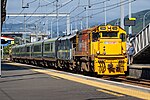
|
Diesel Locomotive | 113 | 70 | 3 | N/A | Wairarapa Connection (KiwiRail provides four diesel-electric locomotives on a "hook-and-tow" basis) | 1979–81 |
| SE Coaches | 
|
Passenger carriage | 100 | 62 | 6 | 3-8 | 1973–75 (introduced in 2008) | |
| SW Coaches | 
|
Passenger carriage | 100 | 62 | 24 | 3-8 | 1973–75 (introduced in 2006) | |
| FP/FT Matangi | 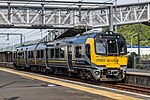
|
EMU | 110 | 68 | 83 | 2 | Kapiti Line, Hutt Valley Line, Melling Branch, Johnsonville Branch | 2008–2012, 2014–2016 |
Future
The 2013 Review and Draft 2014 Review of the Wellington Regional Public Transport Plan confirmed that building additional stations on the Kapiti Line at Raumati and Lindale was no longer recommended, with the cost of new stations outweighing the benefits. The detailed analysis for Raumati (which was a "viability benchmark" for other new stations) said that the modelled peak-hour patronage needed to be about 300 new passengers to justify a new station, and that most Raumati users would have switched from Paraparaumu Station. Network extensions beyond the current Metlink rail operation limits would be by "shuttles or non-electrified services" running to Wellington. This followed a campaign to extend electrified commuter services to Otaki, following the extension of the Kapiti Line to Waikanae in 2011.
Service improvements proposed in May 2017 are double-tracking the line between Trentham and Upper Hutt; a third-platform or passing loop at Porirua Station; and a "turnback" point at Plimmerton Station so that trains can continue in the opposite direction without using a turnaround point. These will ease peak-hour congestion and allow increased trains at busy times. However, they are regarded by KiwiRail as "service enhancements" rather than renewals/maintenance which KiwiRail would pay for, so the GWRC is seeking taxpayer funding towards the $30 million cost before inclusion in the 2017-18 Annual Plan as Rail Scenario 1. Immediate work required first is the replacement of some traction poles on the Hutt Line.
From July 2018, the Hutt Valley and Kapiti lines will run every twenty minutes off-peak on weekdays rather than half-hourly.
In 2019/20, the GWRC is to "renew" the Crofton Downs, Featherston, Silverstream, Wallaceville and Trentham (outer) railway stations.
The Greater Wellington Regional Council endorsed a Wellington Rail Programme Business case for a 30-year programme for regional rail system which included increased rail services as follows, but apparently depends on further government investment., and was to go to Waka Kotahi for endorsement; according to a statement of 1 July 2022:
- Train frequency will be able to progressively improve as infrastructure is improved. Peak train services on the Hutt and Kāpiti lines would be increased in 2025 to four trains per hour, along with improved longer distance services to Masterton and Palmerton North by 2028. The peak service frequency is proposed to step up to six trains per hour (every 10 minutes) on the Hutt and Kāpiti lines by 2032, along with inter-peak services increasing to four trains per hour. The Kāpiti line is expected to further improve to 10 trains per hour during the peak by the mid 2030’s, and the Hutt Line by early 2040’s.
Replacement of diesel-hauled trains
For several years the Greater Wellington Regional Council has put forward proposals to replace the diesel-hauled Capital Connection to Palmerston North and the Wairarapa Connection to Masterton with Dual or Bi-mode trains which would operate on overhead electric power to Waikanae and Upper Hutt respectively, and then on diesel or battery power.
In 2017 it was proposed to run additional Wairarapa trains and upgrade the Wairarapa Line. Funding for new electro-diesel multiple units were included in a $990 million funding bid to NZTA in 2018.
In 2019, the GWRC proposed replacing the Capital Connection and Wairarapa Connection trains with 15 four-car bi-mode multiple units by 2025. These trains are estimated to cost $415 million.
In May 2020, GWRC received $5m in funding from the NZTA to write a business case and commence procurement for replacement rolling stock on Wairarapa Line services and the "Manawatū Line." A fleet of 15 four-car Multiple Units is envisaged. However proposals to the government from 2019 to 2022 have not received funding.
In 2022 the GWRC was progressing a business case with the government for $3-$4 billion electric regional trains to tackle population growth. In 2023 the GWRC again proposed "railcars" for the Wairarapa and Palmerston North services at a capital cost of $874 million, including station upgrades and service/maintenance depots. 88 "trimode" units (i.e. 22 four-car units) are proposed; the present Wairarapa Connection is expected to reach capacity in 2025, and would have peak services increased from three to six each weekday morning and afternoon. The Capital Connection is expected to reach capacity in 2030.
In an April 2023 it was announced that 18 four-car trains will be ordered to replace the Wairarapa Connection and Capital Connection rolling stock on passenger services from Wellington to Masterton and Palmerston North with 18 tri-mode consists, following a request for 22 tri-mode consists from the GWRC. The tri-mode consists will have 250 seats and 4 wheelchair spaces per consist, and will operate on battery or diesel power beyond the electrification limits of Upper Hutt or Waikanae In September 2023 it was announced that WSP would be the "procurement partner" for the hybrid trains. By 21 February 2024 a "satisfactory number" of Expressions of Interest had been received for the new trains. It is hoped that contracts will be signed in 2025, the first train will arrive in 2028 and a full service will be running in 2030.
See also: List of Wellington railway stations| Metlink's commuter rail lines | |
|---|---|
| Current | |
Ferries

Only the western and northern shores of Wellington Harbour are heavily populated, and the trip between these population centres is often as quick along the coast as it is by water: demand for ferries has been lower than might otherwise be expected. Two ferry routes are operated by East by West, a private company: daily between central Wellington and Days Bay on the eastern coast, near Eastbourne, serving Seatoun at peak times from 3 April 2008; and the Harbour Explorer Excursion at weekends, also serving Seatoun. Off-peak and weekend sailings call at Matiu / Somes Island, a nature reserve.
Historically ferries also served Miramar, Karaka Bay, and Eastbourne proper. These routes were discontinued as road connections around the region improved. After the 2016 Kaikōura earthquake, weekend services to Petone temporarily ceased due to wharf damage.
There are also larger road and rail ferries that cross Cook Strait to Picton in the South Island; See Interislander. These are not part of Wellington's public transport system.
Cable Car
Main article: Wellington Cable Car
The Wellington Cable Car runs between the central city and the hill suburb of Kelburn. It is used by commuters travelling to and from work, by people travelling from the city to the Wellington Botanic Garden, and by students at Victoria University.
Despite its name, it is a funicular with two counterbalanced cars permanently attached to each other by a cable, rather than a true cable car, where the cars grip or release the cable as needed. The cable runs through a pulley at the top of the hill, driven by an electric motor. Originally the cable car was a hybrid between a true cable car and a funicular, but retained its name when it was converted to a full funicular.
It is owned and operated by Wellington Cable Car Ltd, a wholly owned subsidiary of Wellington City Council. Until 2007 it was operated under contract by Transfield Services, a private company. Unlike most other public transport in Wellington, it runs without subsidy.
Trams (historic)
Main article: Wellington tramway systemBetween 1878 and 1964, Wellington had trams serving the western, eastern and southern suburbs, with the northern suburbs served by trains. The trams were replaced by buses or trolleybuses, although occasional calls are made for light rail to be reintroduced.
Light rail
Main article: Light rail in WellingtonFollowing the 2010 mayoral elections, Mayor Celia Wade-Brown pledged to investigate light rail between Wellington Station and the Airport. Mayor Justin Lester reaffirmed his support for light rail along the golden mile in 2018.
After the 2023 Elections, The 54th New Zealand Parliament and regional councils decided to scrap the Lets Get Wellington Moving plan, which included light rail.
Notes
- According to data from the Greater Wellington Regional Council, 90% of residents in the Wellington Region used public transport in the 2012/2013 fiscal year, equaling 72 public transport trips taken per capita. This compares with the Auckland Region's 47 and the Canterbury Region's 20 per capita trips taken.
- The funicular (Wellington Cable Car) is not apart of the Metlink branding, but is a transport in the Wellington Region.
References
- "Patronage Statistics". Metlink. Archived from the original on 5 October 2024. Retrieved 5 October 2024.
- Wellington Regional Public Transport Plan 2014 (PDF) (Report). Greater Wellington Regional Council. Archived (PDF) from the original on 21 February 2020. Retrieved 30 May 2020.
- "What Greater Wellington and the Government are doing". Archived from the original on 22 March 2012. Retrieved 28 June 2011.
- "Greater Wellington Regional Council - Annual Report 2018/2019" (PDF). Retrieved 14 August 2024.
- "Wellington Regional Land Transport Strategy target assessment March 2010" (PDF). Archived (PDF) from the original on 22 March 2012. Retrieved 28 June 2011.
- Greater Wellington Regional Council 10-Year Plan 2009-19 - Key Issues Archived 22 March 2012 at the Wayback Machine
- "Greater Wellington shares key initiatives for bus, rail, and ferry amid growing patronage". Metlink. GWRC. Archived from the original on 24 December 2019. Retrieved 24 December 2019.
- ^ "Performance of our network » Metlink". Metlink. Retrieved 20 July 2024.
- "Wellington finally gets Snapper on trains--but only on one line". Stuff/Fairfax. 14 November 2021. Archived from the original on 25 January 2022. Retrieved 25 January 2022.
- "Wellington commuters will be able to use Snapper cards on some trains from October". Stuff/Fairfax. 3 May 2021. Archived from the original on 25 January 2022. Retrieved 25 January 2022.
- "Snapper cards from November". Stuff/Fairfax. 29 October 2022. Archived from the original on 7 May 2022. Retrieved 7 May 2022.
- "Motu Move | NZ Transport Agency Waka Kotahi". www.nzta.govt.nz. Retrieved 19 July 2024.
- "National ticketing system on the way for public transport". The New Zealand Herald. 19 July 2024. Retrieved 19 July 2024.
- Fuller, Piers (30 April 2018). "Wairarapa passengers get first taste of new 'technologically superior' buses". The Dominion Post. Fairfax. Archived from the original on 28 June 2018. Retrieved 27 June 2018.
- Hutton, Catherine (18 June 2018). "'Eerie calm' as nonplussed commuters navigate transport changes". Radio New Zealand. Archived from the original on 28 June 2018. Retrieved 27 June 2018.
- George, Damian (20 June 2018). "Wellington's diesel buses could be phased out in favour of electrics from 2019". The Dominion Post. Fairfax. Archived from the original on 28 June 2018. Retrieved 27 June 2018.
- "Procurement Strategy for Bus Services under PTOM" (PDF). Greater Wellington Regional Council. 7 December 2015. p. 7. Archived (PDF) from the original on 31 January 2018. Retrieved 27 June 2018.
- "Snapper for all Metlink buses". Greater Wellington Regional Council. Archived from the original on 28 June 2018. Retrieved 27 June 2018.
- "Greater Wellington Regional Council - Real time information arrives". Archived from the original on 22 March 2012. Retrieved 28 June 2011.
- "Bike racks on buses - Metlink". www.metlink.org.nz. Archived from the original on 13 December 2019. Retrieved 24 December 2019.
- "On-demand public transport launched in Wellington". www.metlink.org.nz. Archived from the original on 16 May 2022. Retrieved 2 June 2022.
- "Wellingtons trains to be run by French company Transdev after KiwiRail loses contract". The Dominion Post. 17 December 2015. Archived from the original on 17 December 2015. Retrieved 21 January 2016.
- "Monthly rail performance". Metlink Wellington. June 2018. Archived from the original on 21 August 2018. Retrieved 21 August 2018.
- "Electric trains come to Wellington". New Zealand History online. 20 December 2012. Archived from the original on 22 January 2013. Retrieved 7 February 2016.
- "Wellington train disruption could now last days instead of weeks". Stuff/Fairfax. 2023.
- Hurst 2020, pp. 9, 10, 15.
- Hurst 2020, pp. 26, 28, 31, 33, 43, 44.
- "Greater Wellington Public Transport Patronage -- Metlink". Greater Wellington Regional Council. Archived from the original on 13 March 2013. Retrieved 17 March 2013.
- "Wellington Metropolitan Rail 2013/14 Annual Report" (PDF). Greater Wellington Regional Council. 30 June 2014. Archived (PDF) from the original on 24 September 2015. Retrieved 24 July 2015.
- "Train Drain;numbers on Wellington trains collapse". The Post. 17 August 2024.
- "Railfan". New Zealand Railfan. 18 (1). Triple M Publications. December 2011. ISSN 1173-2229.
- Norman, Emily (2 July 2015). "Faster locos mean timely rides - council". Wairarapa Times-Age. Archived from the original on 5 March 2016. Retrieved 24 July 2015.
- Draft Wellington Regional Public Transport Plan, April 2014 p 58
- Wilson, Nigel. "Raumati Station Now". Archived from the original on 9 July 2017. Retrieved 23 February 2011.
- "Train improvements put on hold" Archived 10 August 2017 at the Wayback Machine The Dominion Post (Wellington), 25 May 2017 page A3
- "Metlink—Public transport changes for the Hutt Valley". Upper Hutt City Council. 19 June 2018. Archived from the original on 28 June 2018. Retrieved 27 June 2018.
- "Priority Area – Public transport" in Staying on Track: Key work programme for 2019/20 page 5, from the Greater Wellington Regional Council (GWRC)
- "Greater Wellington endorses bold investment vision for regional rail services". Metlink. 1 July 2022. Archived from the original on 16 July 2022. Retrieved 16 July 2022.
- "Big changes in store for Wellington trains with-Wairarapa improvements on the cards". Stuff (Fairfax). 8 August 2017. Archived from the original on 10 August 2017. Retrieved 9 August 2017.
- "Public transport prioritised with proposals worth $999m in regional plan review". Scoop.co.nz. Greater Wellington Regional Council. 27 June 2018. Archived from the original on 27 June 2018. Retrieved 27 June 2018.
- "Greater Wellington seeks funding for new trains". Greater Wellington Regional Council. 8 August 2019. Archived from the original on 21 August 2019. Retrieved 13 July 2022.
- "$5M in funding for regional trains case to tackle sardine scenario". Metlink. 20 May 2020. Archived from the original on 4 August 2020. Retrieved 23 May 2020.
- "Regional Council plans new trains for Wellington but it'll take six years". Stuff/Fairfax. 11 August 2019. Archived from the original on 12 July 2022. Retrieved 12 July 2022.
- Letter of May 6, 2022 from the Greater Wellington Regional Council Chairperson Daran Ponter to "Dominion Post" Wellington
- "Ageing lower North Island rail needs multimillion dollar cash-boost fast-tracked". Stuff (Fairfax). 29 April 2023. Archived from the original on 16 April 2023. Retrieved 16 April 2023.
- "Government green lights Lower North Island Rail". The Beehive. Archived from the original on 29 April 2023. Retrieved 28 April 2023.
- "What will new hybrid-trains mean for the Wellington region". Stuff (Fairfax). 29 April 2023. Archived from the original on 29 April 2023. Retrieved 29 April 2023.
- "New fleet of trains for Kapiti Coast and Wairarapa". Radio New Zealand news. 29 April 2023. Archived from the original on 29 April 2023. Retrieved 29 April 2023.
- "Detailed business case for Lower North Island Rail Integrated Mobility 2021". gw.govt.nz. Archived from the original on 10 May 2023. Retrieved 19 May 2022.
- "Wheels of Change firmly on track ..." Metlink. 2023.
- "Wairarapa Committee agenda" (PDF). 28 May 2024. p. 158.
- Boyack, Nicholas (26 March 2017). "Ferry operator looking at a service between Petone and Wellington". Stuff. Archived from the original on 25 August 2018. Retrieved 25 August 2018.
- A Wheel on Each Corner, The History of the IPENZ Transportation Group 1956-2006 - Douglass, Malcolm; IPENZ Transportation Group, 2006, Page 12
- Nichols, Lane (18 October 2010). "Just how green will we go under Celia?". The Dominion Post. Archived from the original on 23 October 2012. Retrieved 4 November 2011.
- "New mayor's dream ride". The Dominion Post. 1 November 2010. Archived from the original on 3 January 2011. Retrieved 4 November 2011.
- Develin, Collette; Damian George (4 April 2018). "'Strong likelihood' of billion-dollar light rail system for Wellington, says mayor". The Dominion Post. Fairfax. Archived from the original on 28 June 2018. Retrieved 27 June 2018.
- "Govt and councils agree to kill $7.4b Wellington transport plan". The New Zealand Herald. 16 December 2023. Retrieved 28 August 2024.
Further reading
- Hurst, A. W. (Tony) (2020). Retro Reds to the Rescue: The last years of Wellington suburban train variety. Lower Hutt, NZ: New Zealand Railway & Locomotive Society. ISBN 978-0-9951385-1-3.
External links
| Public transport in the Wellington Region | |||
|---|---|---|---|
| Government | |||
| Rapid transit corridors |
| ||
| Stations / terminals | |||
| Rail | |||
| Ferry | |||
| Bus | |||
| Other | |||
| Government |
|  | ||||||||
|---|---|---|---|---|---|---|---|---|---|---|
| Hospitals | ||||||||||
| Education | ||||||||||
| Public transportation | ||||||||||
| Culture |
| |||||||||
| Places |
| |||||||||
| Bus transport in New Zealand | |||||
|---|---|---|---|---|---|
| Urban bus companies |
| ||||
| Long distance bus companies | |||||
| Tourism bus companies | |||||
| Bus manufacturers | |||||
| Government & regulation | |||||
| History | |||||
| Infrastructure |
| ||||
| | |||||
| Public transport in New Zealand | |
|---|---|
| By region | |
| Authorities | |
| Ticketing | |
| Major inter-regional services |
|
| Advocacy groups | |